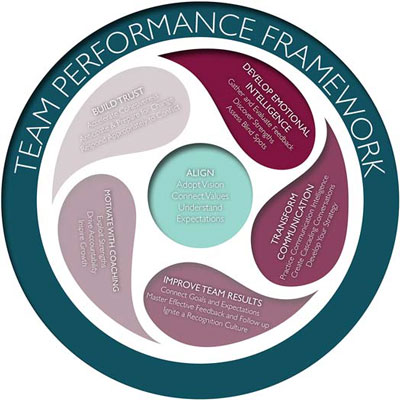Selecting a team framework is a quality process that is important for team success and helps build team culture, consistency, and trust. You may have different frameworks for different reasons. Regardless of the frameworks you use, the key to adoption is to collectively decide and agree on a framework that your team members are willing to apply in their everyday interactions with one another and when leading projects.
In this section, I share with you a simple framework I’ve used for team performance from my 20 years working with teams that you can discuss and customize together with your team. The suggestions I provide can help you lead this important conversation and make decisions that support high levels of virtual team performance.
Use a framework that builds trust and mutual respect
You may be thinking, “What’s a team framework and why do I need one, especially if my team’s values are clear?” Not surprisingly, high levels of team performance, trust, cohesiveness, and respect don’t happen spontaneously or because of a divine intervention.High levels of team performance come from making choices about how your team works together and handles team dynamics, roles, responsibilities, and important processes, such as onboarding, decision-making, and so on. Team values align with and support your framework, but usually they don’t focus on process, roles, and goals. Rather, values define how the team members agree to work together to achieve goals.
I frequently get asked to work with teams that are spinning their wheels trying to figure out why they aren’t functioning at higher levels or why they continue to be dragged down by conflict, sabotage, and conflicting agendas. They usually spend a lot of time defining goals, deadlines, financial measures, expectations, and process. But what they’re missing is a strong team framework as their foundation, which ties everything together and creates team culture.Areas included in a team framework may include any of the following:
- The way the team is structured
- Workflow systems
- Communication systems
- Onboarding process
- Rewards and recognition systems
- Shared vision
- Integrated goals
- Defined roles and responsibilities
- Process for how resources get allocated
- Process for how decisions get made
- What measures define success
- Agreement on how the team builds trust and demonstrates respect
 A sample team performance framework.
A sample team performance framework.Feel free to use this sample framework to start the conversation with your virtual team about the foundational stages, steps, or building blocks that ensure your team is set up for success. Take time to specifically define what your framework means for your team and how your team members live the strategies in the framework daily in every interaction.
Let your virtual team decide the framework
The key to a strong framework isn’t one predetermined by the team leader. Instead, the best way to develop a strong framework is to bring your virtual team together for a strategy session and decide on it together. The more team members weigh in on what to include in the framework, the more buy-in and acceptance they’ll have for adopting it and living it in their day-to-day interaction with each other. They’ll also feel more comfortable and confident calling out other team members when they notice they aren’t operating in accordance with the agreed-upon framework.Here are few questions to ask your team members to involve them in deciding on your team framework:
- What are the five most important questions you need to have answered to feel like a valued team member?
- What must exist for you to build trust and respect with another team member?
- How will we know that the team is performing at its optimal level? What would you notice?
- What poorly defined processes have contributed to dysfunction on other teams you’ve been a part of?
- How do you recommend we agree to resolve team conflict? Make decisions? Manage conflicting priorities?
Your framework is something to share with interview candidates and provide them with information about your team culture. It helps them consider what it will be like to work on your virtual team and what will be expected.

